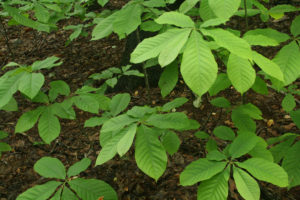 Around this time last year, I wrote a column about paw-paws. The gist of it was that I’d gone on paw-paw hunts twice, in woods belonging to different sets of friends, and come up empty-handed both times. My friends and I assumed that wild animals, or perhaps human scavengers, had consumed the paw-paws before we got to them.
Around this time last year, I wrote a column about paw-paws. The gist of it was that I’d gone on paw-paw hunts twice, in woods belonging to different sets of friends, and come up empty-handed both times. My friends and I assumed that wild animals, or perhaps human scavengers, had consumed the paw-paws before we got to them.
Now I know that we went hunting a few weeks too early.
Late September and early October are prime time for finding ripe paw-paws in these parts. My friend and neighbor Lucy, who has a large patch in her back yard, went the extra mile last spring. She noted where the paw-paws’ maroon blossoms (which smell like rotting meat) were and tied bright ribbons on the branches near them. As the months passed, Lucy watched her paw-paws change from flowers to hard little knots to mature yellow-green fruit, shaped very much like a bean.
I was in Knoxville a couple of weeks ago when I got a text from her: “I picked a paw-paw today. Come on over and eat it!” I stopped by on my way home. “It already smells pretty ripe,” Lucy told me. “We may have waited too late.”
The paw-paw’s skin was dark and mottled and not at all appealing to look at. That’s one reason they’re nearly impossible to find in grocery stores. Paw-paws ripen quickly and bruise easily once they’re off the tree. With a shelf-life of only two or three days, they have to be consumed quickly. Lucy took a paring knife and sliced the paw-paw open. Inside was mushy orange flesh and several seeds, which are about the size of almonds. “You go first,” she said, handing me a spoon.
I took a tentative bite. Paw-paws are sometimes called “custard apples” or “poor man’s bananas.” The consistency of the flesh is, indeed, custard-like and a little gritty. It’s definitely tropical in flavor, a mix between banana and mango, and very, very sweet. Not something I would choose if a really delicious fruit–say a tree-ripened Georgia peach– were available, but certainly not horrible.
Which is why I’m now determined to grow a paw-paw patch at the edge of my own woods. From what I read, it’s not all that complicated. I’ll remove the seeds from all the paw-paws I can find this year and clean the flesh off of them. It’s crucial that the seeds not dry out, so I’ll pop them into a Zip-Lock bag and put it in the refrigerator to mimic wintertime. After at least ninety days, I’ll plant them in fabric pots that can be set directly into the ground once spring arrives. If all goes well, one day I’ll have a paw-paw patch of my very own. And even if I grow tired of eating paw-paws, the monarch butterflies (not to mention possums, raccoons and squirrels) will thank me.
I can hardly wait.
(October 7, 2018)